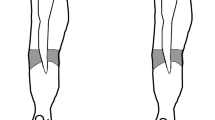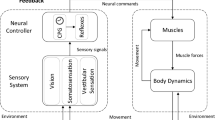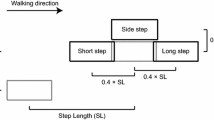Abstract
When walking over stable, complex terrain, visual information about an upcoming foothold is primarily utilized during the preceding step to organize a nearly ballistic forward movement of the body. However, it is often necessary to respond to changes in the position of an intended foothold that occur around step initiation. Although humans are capable of rapidly adjusting foot trajectory mid-swing in response to a perturbation of target position, such movements may disrupt the efficiency and stability of the gait cycle. In the present study, we consider whether walkers sometimes adopt alternative strategies for responding to perturbations that interfere less with ongoing forward locomotion. Subjects walked along a path of irregularly spaced stepping targets projected onto the ground, while their movements were recorded by a full-body motion-capture system. On a subset of trials, the location of one target was perturbed in either a medial–lateral or anterior–posterior direction. We found that subjects were best able to respond to perturbations that occurred during the latter half of the preceding step and that responses to perturbations that occurred during a step were less successful than previously reported in studies using a single-step paradigm. We also found that, when possible, subjects adjusted the ballistic movement of their center of mass in response to perturbations. We conclude that, during continuous walking, strategies for responding to perturbations that rely on reach-like movements of the foot may be less effective than previously assumed. For perturbations that are detected around step initiation, walkers prefer to adapt by tailoring the global, pendular mechanics of the body.








Similar content being viewed by others
Notes
Studies such as Hollands and Marple-Horvat (1996, 2001) used a heavily impoverished visual environment. Stepping targets were small light emitting diodes (LEDs) in an otherwise completely dark hallway. As such, subjects had no access to optic flow information or a focus of expansion in the visual field. It is not immediately clear how behavior in such an impoverished visual scene translates to visually controlled locomotion with intact visual information about the environment.
Maker positions were low-pass filtered prior to analysis using a 4th order Butterworth filter with a cutoff of 7 Hz.
Where noted, unsigned absolute stepping error was used for illustration.
These slightly different measures do not yield different results in this study, but the sum total difference has the ability to capture deviations from pendularity even for trajectories that end at the same spatial location as the simulated pendulum by chance.
The acceleration profile of a step was calculated by taking the second order difference of the position trajectory from a marker placed on the top of the foot.
Here, absolute stepping error is defined as the magnitude of the vector between the landing place of the foot and the center of the relevant target.
The only exceptions will be if a subject's COM is moving precisely at the target.
It is worth noting that in Reynolds' and Day's study, a difference was observed in subjects' ability to make a complete response to the perturbation dependent on whether their step was supported by hand rails. Reynolds and Day interpreted this finding as an indication that balance may play a role in step control.
References
Barton SL, Matthis JS, Fajen BR (2017) Visual regulation of gait: zeroing in on a solution to the complex terrain problem. J Exp Psychol Hum Percept Perform 43(10):1773–1790. https://doi.org/10.1037/xhp0000435
Bauby CE, Kuo AD (2000) Active control of lateral balance in human walking. J Biomech 33(11):1433–1440. https://doi.org/10.1016/S0021-9290(00)00101-9
Chapman GJ, Hollands MA (2006) Age-related differences in stepping performance during step cycle-related removal of vision. Exp Brain Res 174(4):613–621. https://doi.org/10.1007/s00221-006-0507-6
da Silva Costa AA, dos Santos LO, Moraes R (2018) Effect of a cognitive task on online adjustments when avoiding stepping on an obstacle and stepping on a target during walking in young adults. Exp Brain Res 236(8):2387–2397. https://doi.org/10.1007/s00221-018-5310-7
Dale R, Kehoe C, Spivey MJ (2007) Graded motor responses in the time course of categorizing atypical exemplars. Mem Cogn 35(1):15–28. https://doi.org/10.3758/BF03195938
Day BL, Brown P (2001) Evidence for subcortical involvement in the visual control of human reaching. Brain 124(9):1832–1840
Day BL, Lyon IN (2000) Voluntary modification of automatic arm movements evoked by motion of a visual target. Exp Brain Res 130(2):159–168. https://doi.org/10.1007/s002219900218
Desmurget M, Grafton S (2000) Forward modeling allows feedback control for fast reaching movements. Trends Cogn Sci 4(11):423–431. https://doi.org/10.1016/S1364-6613(00)01537-0
Donelan JM, Kram R, Kuo AD (2001) Mechanical and metabolic determinants of the preferred step width in human walking. Proc R Soc B Biol Sci 268(1480):1985–1992. https://doi.org/10.1098/rspb.2001.1761
Franchak JM, Adolph KE (2010) Visually guided navigation: head-mounted eye-tracking of natural locomotion in children and adults. Vis Res 50(24):2766–2774. https://doi.org/10.1016/j.visres.2010.09.024
Garcia M, Chatterjee A, Ruina A, Coleman M (1998) The simplest walking model: stability, complexity, and scaling. J Biomech Eng 120(2):281–288
Heath M, Hodges NJ, Chua R, Elliott D (1998) On-line control of rapid aiming movements: unexpected target perturbations and movement kinematics. Can J Exp Psychol Ottawa 52(4):163–173
Hof AL (2008) The “extrapolated center of mass” concept suggests a simple control of balance in walking. Hum Mov Sci 27(1):112–125. https://doi.org/10.1016/j.humov.2007.08.003
Hollands MA, Marple-Horvat DE (1996) Visually guided stepping under conditions of step cycle-related denial of visual information. Exp Brain Res 109(2):343–356. https://doi.org/10.1007/BF00231792
Hollands M, Marple-Horvat DE (2001) Coordination of eye and leg movements during visually guided stepping. J Mot Behav 33(2):205–216
Hollands MA, Marple-Horvat DE, Henkes S, Rowan AK (1995) Human eye movements during visually guided stepping. J Mot Behav 27(2):155–163. https://doi.org/10.1080/00222895.1995.9941707
Hoogkamer W, Potocanac Z, Duysens J (2015) Quick foot placement adjustments during gait: direction matters. Exp Brain Res 233(12):3349–3357. https://doi.org/10.1007/s00221-015-4401-y
Koolen T, de Boer T, Rebula J, Goswami A, Pratt J (2012) Capturability-based analysis and control of legged locomotion, Part 1: theory and application to three simple gait models. Int J Robot Res 31(9):1094–1113. https://doi.org/10.1177/0278364912452673
Kuo AD (1999) Stabilization of lateral motion in passive dynamic walking. Int J Robot Res 18(9):917–930. https://doi.org/10.1177/02783649922066655
Kuo AD (2002) Energetics of actively powered locomotion using the simplest walking model. J Biomech Eng 124(February):113–120. https://doi.org/10.1115/1.1427703
Kuo AD (2007) The six determinants of gait and the inverted pendulum analogy: a dynamic walking perspective. Hum Mov Sci 26(4):617–656. https://doi.org/10.1016/j.humov.2007.04.003
Kuo AD, Donelan JM, Ruina A (2005) Energetic Consequences of walking like an inverted pendulum: step-to-step transitions. Exerc Sport Sci Rev 33(2):88–97
Marigold DS, Patla AE (2007) Gaze fixation patterns for negotiating complex ground terrain. Neuroscience 144(1):302–313. https://doi.org/10.1016/j.neuroscience.2006.09.006
Marigold DS, Patla AE (2008) Visual information from the lower visual field is important for walking across multi-surface terrain. Exp Brain Res 188(1):23–31. https://doi.org/10.1007/s00221-008-1335-7
Matthis JS, Fajen BR (2013) Humans exploit the biomechanics of bipedal gait during visually guided walking over complex terrain. Proc R Soc B Biol Sci 280(1762):20130700. https://doi.org/10.1098/rspb.2013.0700
Matthis JS, Fajen BR (2014) Visual control of foot placement when walking over rough terrain. J Vis 11(11):915. https://doi.org/10.1167/11.11.915
Matthis JS, Barton SL, Fajen BR (2015) The biomechanics of walking shape the use of visual information during locomotion over complex terrain. J Vis 15(3):10. https://doi.org/10.1167/15.3.10
Matthis JS, Barton SL, Fajen BR (2017) The critical control phase for the visual control of walking over complex terrain. Proc Natl Acad Sci USA 114(11):E6720–E6729. https://doi.org/10.1073/pnas.1611699114
Matthis JS, Yates JL, Hayhoe MM (2018) Gaze and the control of foot placement when walking in natural terrain. Curr Biol. https://doi.org/10.1016/j.cub.2018.03.008
McGeer T (1990) Passive dynamic walking. Int J Robot Res 9(2):62–82
Mochon S, McMahon TA (1980) Ballistic walking. J Biomech 13(1):49–57. https://doi.org/10.1016/0021-9290(80)90007-X
Moraes R (2014) A model for selecting alternate foot placement during human locomotion. Psychol Neurosci 7(3):319–329. https://doi.org/10.3922/j.psns.2014.038
Moraes R, Patla AE (2006) Determinants guiding alternate foot placement selection and the behavioral responses are similar when avoiding a real or a virtual obstacle. Exp Brain Res 171(4):497–510. https://doi.org/10.1007/s00221-005-0297-2
Moraes R, Lewis MA, Patla AE (2004) Strategies and determinants for selection of alternate foot placement during human locomotion: influence of spatial and temporal constraints. Exp Brain Res 159(1):1–13. https://doi.org/10.1007/s00221-004-1888-z
Moraes R, Allard F, Patla AE (2007) Validating determinants for an alternate foot placement selection algorithm during human locomotion in cluttered terrain. J Neurophysiol 98(4):1928–1940. https://doi.org/10.1152/jn.00044.2006
Nakagawa S, Schielzeth H (2013) A general and simple method for obtaining R2 from generalized linear mixed-effects models. Methods Ecol Evol 4(2):133–142. https://doi.org/10.1111/j.2041-210x.2012.00261.x
O’Connor SM, Kuo AD (2009) Direction-dependent control of balance during walking and standing. J Neurophysiol 102(3):1411–1419. https://doi.org/10.1152/jn.00131.2009
Patla AE (1997) Understanding the roles of vision in the control of human locomotion. Gait Posture 5(1):54–69. https://doi.org/10.1016/S0966-6362(96)01109-5
Patla AE, Vickers JN (1997) Where and when do we look as we approach and step over an obstacle in the travel path? NeuroReport 8(17):3661–3665. https://doi.org/10.1097/00001756-199712010-00002
Prablanc C, Martin O (1992) Automatic control during hand reaching at undetected two-dimensional target displacements. J Neurophysiol 67(2):455–469. https://doi.org/10.1152/jn.1992.67.2.455
Reynolds RF, Day BL (2005a) Rapid visuo-motor processes drive the leg regardless of balance constraints. Curr Biol 15(2):48–49. https://doi.org/10.1016/j.cub.2004.12.051
Reynolds RF, Day BL (2005b) Visual guidance of the human foot during a step. J Physiol 569(Pt 2):677–684. https://doi.org/10.1113/jphysiol.2005.095869
Saunders JA, Knill DC (2003) Humans use continuous visual feedback from the hand to control fast reaching movements. Exp Brain Res 152(3):341–352. https://doi.org/10.1007/s00221-003-1525-2
Tsai R (1987) A versatile camera calibration technique for high-accuracy 3D machine vision metrology using off-the-shelf TV cameras and lenses. IEEE J Robot Autom 3(4):323–344. https://doi.org/10.1109/JRA.1987.1087109
Wang Y, Srinivasan M (2014) Stepping in the direction of the fall: the next foot placement can be predicted from current upper body state in steady-state walking. Biol Lett 10(9):20140405. https://doi.org/10.1098/rsbl.2014.0405
Weerdesteyn V, Nienhuis B, Hampsink B, Duysens J (2004) Gait adjustments in response to an obstacle are faster than voluntary reactions. Hum Mov Sci 23(3–4):351–363
Young WR, Hollands MA (2012) Evidence for age-related decline in visuomotor function and reactive stepping adjustments. Gait Posture 36(3):477–481. https://doi.org/10.1016/j.gaitpost.2012.04.009
Zettel JL, Holbeche A, McIlroy WE, Maki BE (2005) Redirection of gaze and switching of attention during rapid stepping reactions evoked by unpredictable postural perturbation. Exp Brain Res 165(3):392–401. https://doi.org/10.1007/s00221-005-2310-1
Acknowledgements
This research was supported by a grant from the National Science Foundation (1431087).
Author information
Authors and Affiliations
Corresponding author
Additional information
Publisher's Note
Springer Nature remains neutral with regard to jurisdictional claims in published maps and institutional affiliations.
Appendix: Trajectory detection with MANOVA
Appendix: Trajectory detection with MANOVA
To avoid Type-I errors when performing the search for deviations along the acceleration trajectories, a nominal value for expected “hit rates” was needed. That is, a threshold was needed that would quantify how many significant deviations in a row would be detected in the trajectory data by chance. To find this threshold, we employed a method developed by Dale et al. (2007) which used a bootstrap search for the nominal runs of significant deviations in a random set of data with the same physical and statistical properties.
To start, trajectories were time-normalized using a spline interpolation, such that the previous-step, current-step, and next-step portions were each 100 datapoints long. Thus, each point along the trajectory corresponded to a percentage of the step and could be directly compared. For each subject, average trajectories for each of the 17 experimental conditions (four perturbation times, four perturbation directions, and one unperturbed condition) were computed by taking the mean across each timepoint in all trajectories for each condition. This led to 12 subjects × (4 timing × 4 direction + 1 control) = 204 trajectories. These 204 trajectories were used to construct a series of simulated “experiments”.
Each simulated experiment involved comparing one timing and direction condition pair to control trajectories (e.g., perturbations at 0.99-steps in the medial direction compared to unperturbed walking). This entailed 24 trajectories: one manipulated and one controlled per subject. For each timepoint along the trajectories, the subject scores for the manipulated and control were used to create hypothetical distributions using the mean and standard deviations across subjects from which new simulated subjects could be drawn. For example, at each timepoint, a group of 12 x, y, and z acceleration values were drawn for the perturbed and unperturbed trajectories from normal distributions defined by the respective means and standard deviations. This gave new acceleration values for the perturbed trial and unperturbed trial. A repeated-measures multivariate analysis of variance (MANOVA) was used to decide if there was a significant difference between the perturbed and unperturbed trajectories at this timepoint, where the x, y, and z accelerations were taken as joint outcome measures. The p-value of this test was logged, and the procedure moved to the next timepoint and repeated.
This process was repeated along the entire length to the perturbed and unperturbed trajectory, and a p-value at each timepoint was logged. This trajectory of p-values could then be analyzed to determine how many times a run of p-values with a specific length n occurred. For example, there might 10 runs of 1 p < 0.05 alone, 6 runs of 2 p < 0.05 in a row, 4 runs of 3 p < 0.05 in a row. The process was repeated for each combination of perturbed trial and control trial, producing a run count for each condition. This entire process was then repeated 10,000 times. This produced 10,000 p-value run counts for each condition in the experiment. The number of times a particular run of length n was observed out of 10,000 was then used to quantify the likelihood of observing a run of length n by chance in the collected data. Runs of four significant p-values in a row were found to occur less than 1% of the time, so four was chosen as the threshold by which a significant deviation between trajectories would be identified. Thus, the first point at which two trajectories were found to be significantly different for four or more time points in a row along the length of trajectories was determined to be an accurate point of divergence. Because the MANOVA used to compute this divergence point consumed all subject data, no variance metric was obtainable for this particular measure.
Rights and permissions
About this article
Cite this article
Barton, S.L., Matthis, J.S. & Fajen, B.R. Control strategies for rapid, visually guided adjustments of the foot during continuous walking. Exp Brain Res 237, 1673–1690 (2019). https://doi.org/10.1007/s00221-019-05538-7
Received:
Accepted:
Published:
Issue Date:
DOI: https://doi.org/10.1007/s00221-019-05538-7




